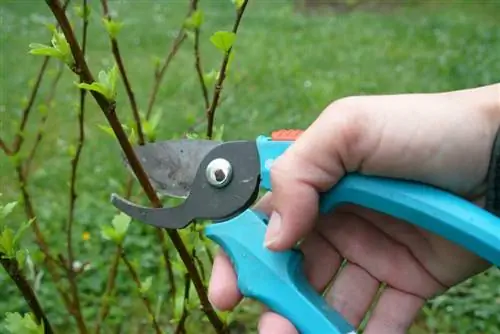- Author admin [email protected].
- Public 2023-12-17 03:39.
- Last modified 2025-01-24 12:45.
For many years it was believed that ticks sat in the leaves of trees. It was believed that ticks then dropped onto their host, a human or a dog. For this reason, it was assumed that one would be protected from ticks in an open field or meadow without trees. However, it has now been proven that ticks are rarely found above 1.50 m. That means they sit on grass and in bushes on leaves.
How do ticks form and how do they get into the garden?
Ticks go through three different stages of development after hatching: from the larva to the nymph to the adult tick. For each of these three development steps, the tick needs blood, which it obtains from a host. Just one adult tick lays up to 3,000 eggs in the garden, starting the pest's life cycle all over again.
Mice are among the main hosts of ticks and it is only through rodents that ticks get into the home garden. Unfortunately, mice are not very clean animals and often carry pathogens such as TBE or Lyme disease. By sucking blood, the ticks also become infected with the pathogens, which means that the next bite can be life-threatening for humans.
The danger lurks in the undergrowth
Even today, many people believe that ticks only live on trees in the forest. This can quickly prove to be a fatal mistake after a sting. Ticks do not jump onto the host's body. Your legs are not designed to jump. Although ticks can move on the skin of a person or animal to find the right place to bite, they cannot jump a great distance from the leaf to a person (the name tick is a bit misleading here). The tick gets to the host by being taken away by him. As people walk across meadows and brush against bushes as they pass by, they unconsciously pick up the tick.
Ticks live exclusively in bushes, undergrowth and tall grass. Today, scientists have discovered that the danger of ticks in home gardens is far too often underestimated: people who often work in the garden and touch grass, bushes and bushes have a much greater risk of contracting Lyme disease than, for example, joggers who are regularly active in the forest. These scientists have also found that on average one in five ticks can transmit Borrelia.
What makes ticks so dangerous?
As soon as a person touches grass, shrubs and bushes, ticks can be removed unnoticed. In most cases, they crawl around on people's clothing or skin for a while before they find a suitable spot and bite. Since blood loss is very minimal when a tick bites, many people only notice the bite when it is already too late. The minimal blood loss is not a problem for the affected people if it were not for the pathogens already mentioned.
When working in the garden or playing on the lawn, it is therefore very important not to have any exposed parts of your body (for example, pulling your socks over your trouser legs). Wearing light-colored clothing is also beneficial, as a small, dark tick is easier to spot on light-colored clothing. Anyone who has trimmed their bushes or picked up mown grass should therefore wear gloves and check their hands and arms regularly; Hands, arms, neck and head should be checked, especially after finishing work. If possible, children should not walk barefoot on the lawn, but should always wear socks and sturdy shoes. Here too, you should examine the possible parts of your body carefully in the evening.
The preventive measures at a glance
- Wearing long-sleeved light-colored tops and light-colored long pants (this way the ticks don't come into contact with the skin as quickly and are easier to see on the light-colored fabric)
- Socks should be pulled over the trouser legs
- After gardening, the entire body should be examined carefully (pay particular attention to the neck, head, back of the knees, armpits and crotch)
To the chagrin of many gardeners, the usual protective measures must be taken even in summer temperatures.
What to do if a tick still bites?
If a tick has bitten despite long clothing and a thorough examination, it should be removed as quickly as possible. To remove the tick safely and correctly, it is best to follow these four tips:
- Never use nail polish remover, gasoline or alcohol (the tick will come off more quickly, but the transmission of Borrelia will increase dramatically).
- Only after removing the tick disinfect the affected area with alcohol or an ointment containing iodine.
- If the tick is in a place that is difficult to access, a second person should be asked for help.
- After the first tick is found, you should continue looking, after all, a person can easily be bitten by several ticks.
- If you are not sure how best to remove the tick, you should definitely consult a doctor.






